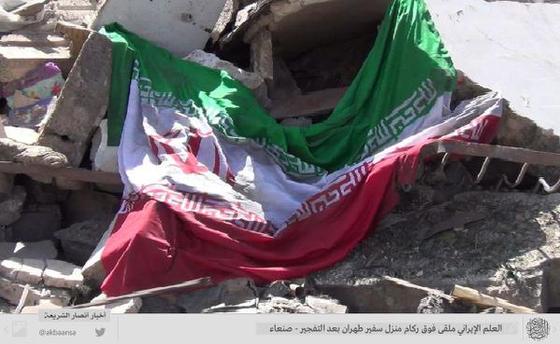 "The Iranian flag thrown upon the rubble of the residence of Tehran's ambassador following the explosion." Source: Al Malahem Media Foundation.
"The Iranian flag thrown upon the rubble of the residence of Tehran's ambassador following the explosion." Source: Al Malahem Media Foundation.
A Twitter account linked to al Qaeda in the Arabian Peninsula (AQAP) has claimed credit for an explosion that occurred early this morning in the diplomatic Hadda section of Sana'a outside the residence of the Iranian ambassador to Yemen. The timing of the attack, which occurred the week after the ambassador, Hossein Niknam, presented his credentials to Yemeni authorities, suggests that AQAP had been waiting for his arrival in the Yemeni capital.
AQAP stated that its fighters parked a vehicle-borne improvised explosive device (VBIED) outside the ambassador's house and detonated the explosive at precisely 9:02 a.m. While official reports suggested that one guard and two pedestrians were killed, the AQAP statement claimed that an unspecified number of people were wounded and killed in the attack, "including Iranians working at the embassy and its guards, in addition to the destruction of large sections of the residence."
The AQAP statement boasted that "despite the security precautions put in place by the Yemeni regime forces and the Houthi political committees, the mujahideen managed to park the explosive laden vehicle and detonate it." Additionally, the statement claimed that the explosion was so strong that it shattered the windows of nearby buildings allegedly owned by Yemeni officials and diplomats.
Iran has been accused of supporting the Houthis, northern rebels who hail from Yemen's Zaydi sect of Shiite Islam, since a civil war between the insurgents and Yemeni military forces erupted in 2004. Some indications of this alleged support include the Yemeni military's October 2009 seizure of an Iranian ship carrying anti-tank weapons, as well as a January 2013 joint US-Yemeni military operation that captured another ship containing a cache of weapons. Despite Iranian denials, markings on the confiscated weapons indicated they came from Iran's Revolutionary Guard Corps. US officials reported that the weapons were headed to the Shiite insurgents in Yemen's northern provinces.
AQAP has capitalized on these suspicions of Iranian involvement and has made efforts to portray itself as the champion of Yemen's Sunni tribes in the face of the Shiite Houthi onslaught. The terrorist group routinely refers to the Houthis as "Iranian agents," and it has framed the insurgency as an Iranian political and sectarian plot to extend Shiite control throughout the Sunni world.
These longstanding accusations took on new significance when Iranian officials welcomed the Houthi rebels' southward military advance from their northern redoubts in Sa'dah province this summer, culminating in the fall of Sana'a in late September. Shortly thereafter, Ali Riza Zakani, a member of the Iranian Majlis (Parliament) commented, "Three Arab capitals have already fallen into Iran's hands," suggesting that Sana'a would be the fourth. Zakani added that the Houthi rebellion in Yemen is "a natural extension of the Iranian revolution." Ali Akbar Velayati, a seasoned Iranian politician and close adviser to the Supreme Leader announced, "The Islamic Republic of Iran supports the rightful struggles of Ansar Allah [the Houthis] in Yemen."
Today's bombing was not the first time AQAP has targeted Iranian interests in Yemen. Yemeni officials have claimed that AQAP was behind the July 2013 kidnapping of Iranian diplomat Nour Ahmad Nikbakht near the Iranian embassy in Sana'a. And Ali Asghar Asadi, Iran's economic attache in Sana'a, was killed in a drive-by shooting in the capital in January 2014 that was carried out by gunmen believed to belong to AQAP.
As the Houthis continue their march throughout Yemen, questions continue to arise regarding the extent of Iran's support of the rebellion. Although the degree of Iranian involvement remains unclear, today's bombing confirms that the Islamic Republic is being directly targeted by AQAP both for retaliatory reasons and as a public relations attempt to unite Yemen's Sunni population against Shiites and foreigners.
The following pictures were released along with the statement claiming credit for the bombing:
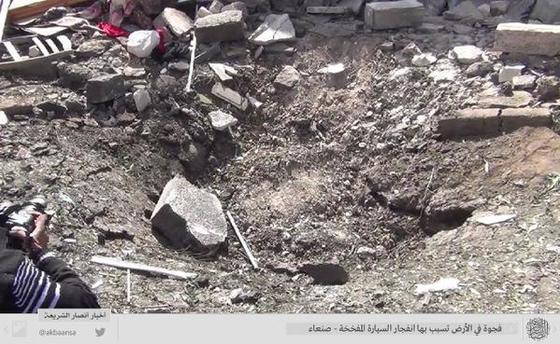 The caption reads: "A hole in the ground caused by the detonation of the explosive-laden vehicle - Sana'a."
The caption reads: "A hole in the ground caused by the detonation of the explosive-laden vehicle - Sana'a."
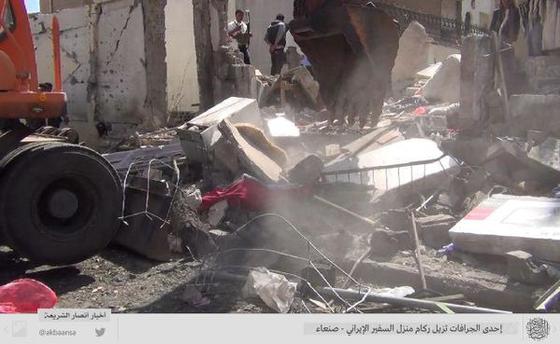 The caption reads: "One of the bulldozers removing the rubble of the Iranian ambassador's house - Sana'a."
The caption reads: "One of the bulldozers removing the rubble of the Iranian ambassador's house - Sana'a."
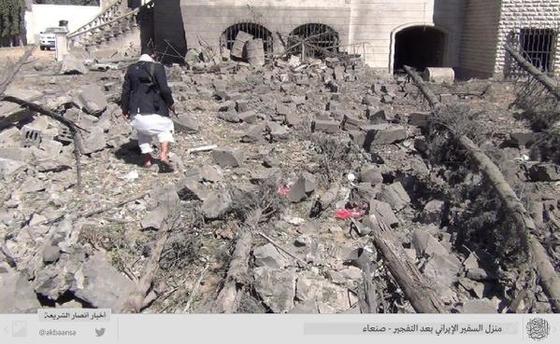 The caption reads: "The Iranian ambassador's house following the explosion - Sana'a."
The caption reads: "The Iranian ambassador's house following the explosion - Sana'a."
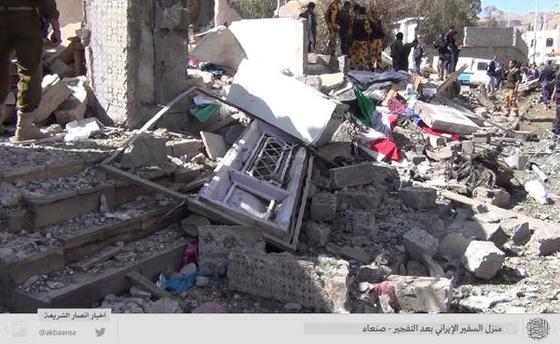 The caption reads: "The Iranian ambassador's house following the explosion - Sana'a."
The caption reads: "The Iranian ambassador's house following the explosion - Sana'a."